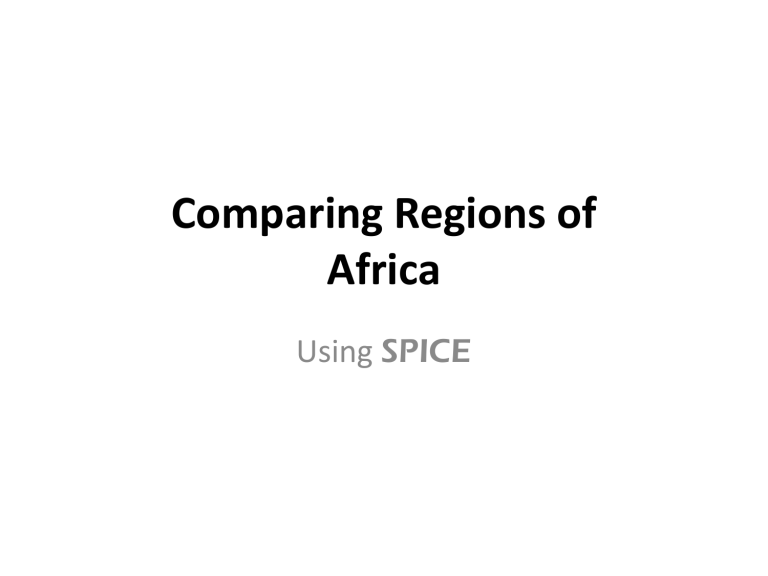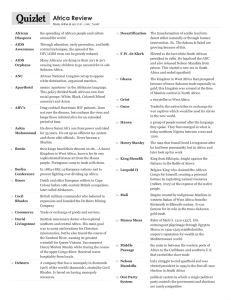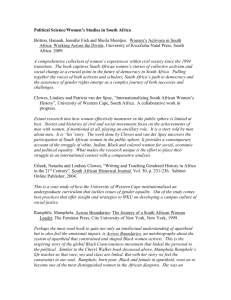Africa SPICE Comparison - pamelalewis

Comparing Regions of
Africa
Using SPICE
Nigeria
After Independence
• Government lacked stability
• Economy relied upon subsistence farming and oil exports
• Africa’s most populous nation
132 million people
Three Major Nigerian Ethnic Groups
Igbo, Hausa , Yoruba
Yoruba
Igbo
Hausa
Biafran War
The Nigerian civil war, popularly known all over the world as the
"Biafran War" was fought from 2 July 1967 to 15 January
1970. The war was between the then Eastern Region of
Nigeria and the rest of the country. The Eastern Region declared itself an independent state (Biafra) which was regarded as an act of secession by the Federal Military
Government of Nigeria. To avoid disintegration of the country, the central government was left with only one choice of bringing back the region to the main fold by force.
Biafran War – Long Term Cause
The British left Nigeria only in 1960. When they left, there were two essential tribes there,
Ibos and Hausas. The Ibos were sort of the civil service class, the governing class, and the
Hausas were not. As soon as the British left, the two ethnic groups were in a civil war against each other in a quest for power.
Effects of Colonialism in Nigeria
Under British colonial rule, the Ibos had become an educated élite and after independence there was much resentment of them. In 1966 thousands of lbos living in the north were killed in ethnic rioting, and as a result many Ibos fled their homes and moved to traditional Ibo territory in the south-east of Nigeria.
Reader, Recorder, Reporter
• Why was the Biafra created and what was the result?
Hall Of Fame – Wole Soyinka
Soyinka explores the issues of colonialism and independence in many of his writings. He mostly writes from the perspective of the Yoruba culture and his love of human liberty, often criticizing colonialism and condemning the repression and corruption in
African politics. He was jailed several times for expressing his views. Best known for his plays, in
1986 Soyinka became the first African to win the
Nobel Prize in Literature.
Hall of Fame or Wall of Shame
Translate the following phrases. Identify the
POV:
• “we cannot meet them on their turf”
• “The spirit becomes important, and no gun can silence that”?
Do you think Ken Saro-Wiwa was a hero? Why or why not? Write a thesis statement in response.
Nigeria Today
• Democratic and free elections in Nigeria
• Subsistence Farming
• Biggest oil exporting country
• End of 30 yr military rule
• President Olusegun Obasanjo leader since
1976 but officially elected as president in
1979.
Kenya
What foreign powers controlled parts of Kenya during its history?
Arabs, Portuguese, British
How did the British expand the settlement of
Kenya?
It encouraged Europeans to establish large farms
Trade Across Regions in Africa
East African trading cities were situated along the coast. Although none of the goods traded were the same in the cities, silk, precious stones, and certain spices would have been considered luxury goods in Italy.
Why did East African trading cities depend on trade winds?
They did not have overland routes that European traders did.
Mau Mau Rebellion
During British occupation, native East African groups led by the Kikuyu established the Kenya African Union to protest British rule. Within this organization, som Kikuyu members (referred to as the Mau Mau) secretly pursued more aggressive actions to force the British to enact reforms. In response, the British launched a military campaign to crush this freedom movement. The fighting resulted in the deaths of more than 11,000 Kenyans and about 2,000 other Africans and those who supported the British.
Sports
Kenyan Athletes
As the end of 2006, Kenyan runners held the world track and field outdoor records for
1,000 meter, 3,000 meter and marathon races in the men’s division and the 20,000 and
30,000 meter races in the women’s division.
The Many Faces of South Africa
This slide show will introduce you to some of the key structural dynamics of the country’s history
South Africa is….
• AN IMPERIAL SOCIETY
• A PLANTATION SOCIETY
Language
Because it has a long history of settlement by “Bantuspeaking” African peoples, South Africa today has eleven official languages. Two are derived from European settlers; nine are African languages. Zulu and Xhosa speakers make up about 40% of the population. Still, many if not most South Africans are multilingual.
Language Policy —the imposition of Afrikaans in “Bantu education”—helped spark the
Soweto student revolt of 1976
African Chiefdoms
King Shaka,
Zulu warrior
“Traditional” Societies
• The original inhabitants of southern Africa consisted of many different African cultures.
• As the previous map shows, each group had a different encounter with European expansion. Some, like the Khoi and San peoples of the Western Cape, were mostly wiped out or enslaved. Others, like the
Xhosa, Zulu, and Sotho, were conquered, incorporated, or preserved nominal independence, at different historical moments and through different processes.
“Traditional” Societies, cont.
• All these African groups found they had to negotiate a delicate balance between preserving their own traditions, cultures, and social/political structures and giving way to the forces of modernity—industry,
Christianity, empire—brought to their world by
Europeans.
• The key moment in Zulu tradition was the rise and fall of King Shaka , 1816-1828. For Xhosa, it can be seen as the Cattle-Killing of 1856-57 .
“Tradition”
• Listen to this short podcast on the problem of
“tradition” in South African history.
t
Click here for
Podcas
Slave Trade Routes to Cape
Between 1658 and
1808, the Dutch and British empires transported
60,000 slaves to the Western Cape.
The descendants of South African slaves, mixed with the original inhabitants of the Cape, as well as the first Dutch settlers, generated a large mixed-race population in the western third of South Africa —the “coloured” population.
As you can see, this was part of the Indian Ocean slave trade, not the Atlantic trade.
This group of people spoke (and speak) Afrikaans, and embraced Christianity (some remained Muslims). Yet whites continued to treat them as second-class citizens. At the same time, unlike Xhosa, Zulu, and other “bantu” peoples, they had little claim to an African “tradition”, way of life, or geographic territory of their own.
The British ended the slave trade in
1808, and abolished slavery in their empire in
1833. There were
38,000 slaves in the Cape in 1833,
By 1795, the city of Cape Town had
25,000 slaves and 25,000 free inhabitants.
Look at the graph on the next slide; Cape slavery, in world terms, was much less significant than slavery in the
Western hemisphere.
# of slaves @ emancipation
(1000s)
4,000
3,500
3,000
2,500
2,000
1,500
1,000
500
0
Brazil USA BWI Cape(38,000)
Slaves
Settler Societies
• As Europeans began to colonize Africa, two models of colonial power developed. In most cases, the French,
Dutch, Portuguese, and British planted a flag, a few administrators, soldiers, and missionaries, and exploited local resources.
• But in a few places—South Africa was one—they developed settler societies, planting a fully European way of life, culture, and political system in a new land. Of course, they didn’t bother to ask the original inhabitants.
• Both the Dutch and the British developed competing settler societies in Southern Africa, though the Dutch got there first.
What is a Frontier?
• European settlers who establish themselves on the edge of a continent—North America, Africa,
Australia—never seem willing to stay put….they imagine that the “untamed” land beyond the next mountain range is not being used properly by the
“natives”, or needs Christianity and civilization. So, as the maps on the next slide indicates, they expand their territorial ambitions. In S. Africa, Europeans moved from the West eastwards, eventually encountering Bantu-speaking Africans. This caused conflict.
The “Frontier”and the Great Trek
Three frontiers
• From the early 19 th century, the British empire controlled the Cape. As British settlers moved westward, they brought certain beliefs, ideas, and governmental structures with them.
• Many Dutch—or Boers—didn’t like living in the British empire. So, in the 1830s, 6,000 of them set out on the “Great Trek”, expanding their own “frontier” values into the African interior. Look again at the following maps.
The “Frontier”and the Great Trek
For a glimpse at the rationale for the
Boers’ trek, click here and here . Why did they want to leave the British empire? We will return to this important issue next week.
A Third Frontier: Mfecane
• But Africans had their own
“frontier.” King Shaka’s
“Mfecane” (1820s) drove many non-Zulu to the
South and west, where they collided with
Europeans.
• In 1838, the voortrekkers
(Boers) came into contact with the Zulu in Northern
Natal—an encounter that became central to the historical mythology of both peoples.
For a description of the competing memories of the Zulu-Boer conflict, see the excerpt from A. Hochschild, The Mirror
at Midnight, pp. 61-70.
British Empire, 1850/1910
A Corner of the Empire
• The British presence in Southern Africa made the region part of the enormous British Empire—precisely what the Boers rejected.
• Until the discovery of diamonds (1867) and gold (1886), it remained a relatively unimportant corner of the empire as far as the Brits were concerned
• But imperial ideology had a major impact on all those who lived in southern Africa. It led to the abolition of slavery; to a particular form of control over land, labor, minerals, and the region’s African inhabitants; and to war, between the Boer
Republics and the Empire, and between the Empire and
Africans.
• In Module 1 we will consider the competing values and ideology of the British imperial worldview and that advanced by their European rivals, the Boers, who sought a republican form of government in the Transvaal and Orange Free State, in the North & East of SA.
Indian Indentured Labour, 1860-1911
The British imperial system made it possible for sugar plantations in Natal to secure a non-African labor force through a contract, or indentured labor system. Between 1860-1911, about 150,000 Indians came to
Natal on 5-year indentures..
What would these workers, pejoratively called “coolies”, do when their contract was complete? What would their status in southern Africa be?
This question was addressed by the Indian community’s most famous member, Mohandas K.
Gandhi, who arrived in 1894.
As late as 1970, South Africa’s Indian population continued to be concentrated near Durban, in Natal, near where their forbears had arrived a century before.
Like the coloured people of the
Western Cape, they formed an intermediate layer, facing racism and discrimination, but having more rights than Africans. Unlike coloured people, after 1947 they had an independent national entity —India—to speak up for them.
An Industrial Society
• Unlike much of Africa, by the 20 th century SA began to develop an industrial economy—but of a special type
• Originally, economic growth depended on minerals, especially gold. This required massive inputs of cheap labor—the crucial question of the “mineral revolution” was how to get this labor
By the mid-20 th century, manufacturing began to dominate the South African economy. What kind of labor force did this require?
In either case —mining & manufacturing—economic growth brought dramatic changes to SA society. It meant:
The spread of wage labor
The expansion of the migrant labor system
The development of urban areas
The question of trade unions
BUT how could this process be made compatible with a social order built on slavery, segregation, colonialism, coerced labor, and racial subordination?
In other words: was the growth of capitalism in South Africa promoted or retarded by the country’s racial system?
European
--Brit
--Boer
Indian
African
--Xhosa
--Zulu
Settlers
Farmers
Empire
Coloured Indigenous
Slaves from
East
Indentured workers
Independent
Migrant labor
“Frontier”
Great
Trek
English
Afrikaans
Western
Cape
Natal
Eastern part of SA
Afrikaans
Islam
Christianity
Hindi
English
Gandhi
“Tradition”
Cattle-killing
Shaka








